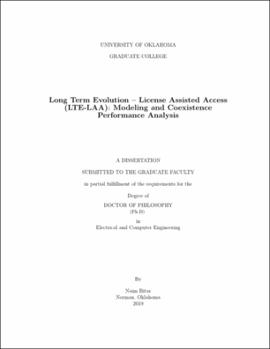| dc.description.abstract | Wireless communication built upon radio spectrum plays an instrumental role in today's modern world. With the explosive growth of mobile data traffic, mobile cellular networks need more spectrum to boost their system capacity. Long Term Evolution (LTE) technology leveraging the unlicensed band is anticipated to provide a solution to address this challenge. However, ensuring fair operation in terms of spectrum sharing with current unlicensed spectrum incumbents remains a key challenge for the success and viability of Unlicensed LTE (U-LTE). In particular, fair co-existence between unlicensed LTE and the Institute of Electrical and Electronics Engineers (IEEE) 802.11x standard, known as Wi-Fi, remains a principal concern, due to the ubiquitous, high-throughput and high capacity nature of both technologies.
This work addresses the problem of modeling and evaluating the coexistence of LTE License-Assisted-Access (LTE-LAA) in the unlicensed band. The research work presents a novel analytical model using Markov Chain to accurately model the LAA Listen-Before-Talk (LBT) scheme, as specified in the final technical specification 36.213 of the 3rd Generation Partnership Project (3GPP) release 13 and 14. Model validation is demonstrated through numerical and simulation result comparison. Model performance evaluation is examined and contrasted with the IEEE 802.11 Distributed Coordination Function (DCF) and analysis results are subsequently presented and discussed herein. Finally, succeeding model development, a comprehensive coexistence performance analysis study is developed and completed examining the coexistence of homogeneous and heterogeneous network scenarios consisting of LTE-LAA and Wi-Fi nodes. As a result, the contribution of this work establishes a novel apparatus that facilitates numerical analysis of the LTE-LAA LBT mechanism and enables numerical comparison of future enhancements with the standardized LTE-LAA framework. In addition, this work delivers a delineating, unequivocal and in-depth examination of the effects and implications that the LTE-LAA LBT mechanism and its parameters have on coexistence performance of homogeneous and heterogeneous co-channel and co-located networks. | en_US |
